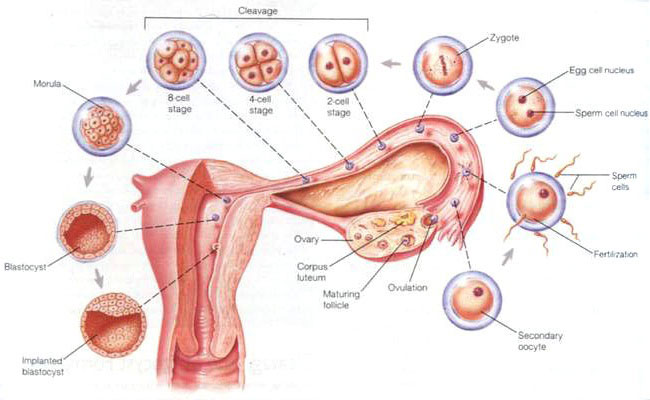The Reproductive System of a woman The Menstrual Cycle
The Hormones The Reproductive System of a Man The Role of Testosterone The Sperm's Odyssey in the Female Reproductive Tract The Process of FertilisationThe Menstrual Cycle
The aspect of the reproductive system that women are most aware of is the menstrual period which they have every month. The menstrual cycle is the time from the beginning of one period to the beginning of the next one. Usually, menstrual cycles last about 28- 35 days, though anywhere from 3 to 6 weeks is considered normal.
During the menstrual cycle, the uterus gets ready for pregnancy. Under the influence of the hormones estrogen and progesterone, its lining grows rich and thick to prepare for the fertilized egg. If pregnancy doesn't occur, the uterus must get rid of this lining so that it can grow a new one in the next cycle. The old lining passes out of the uterus through the vagina as the menstrual flow.
The menstrual flow thus consists of: the shed uterine lining; blood (this comes from the blood vessels which are torn when the lining is shed); and the degenerated unfertilised egg.
If the menstrual flow is heavy, there may sometimes be clots in it. Sometimes the uterine lining is shed as large fragments - and these may sometimes looks like bits of pregnancy tissue to some women, who think they are miscarrying.
Different Stages of Menstrual Cycle
The menstrual cycle is characterised with the following four stages:
1) Menstrual stage
2) Follicular stage
3) Ovulation stage
4) Luteal stage
The menstrual stage starts from the 1st day of menstrual period and ends on the 5th day of menstruation. During this period the symptom of menstruation like discharge of menstrual fluid, menstrual cramps etc; are experienced. The follicular stage also starts on the 1st of day of menstruation itself and it last till the 13th day. During this phase the egg cells begin to mature and the lining of the uterus (endometrium) also develops. On the 14th day, a mature egg is released. This stage is known as ovulation stage.
Luteal stage begins on the 15th day and lasts up-to the 28th day ie; till the end of the menstrual cycle. The egg is available for fertilisation only for 24 hours ie; till the 15th day and if the egg is not fertilised by a
sperm it subsides along with the menstrual flow. The hormone due to which the endometrium of uterus is retained is exhausted and the menstrual cycle ends. With this the new menstrual cycle begins.
Menstrual Cycle and Pregnancy
If a woman is
trying to get pregnant, her menstrual cycle will play an important role in determining her most fertile days. It is a must to have intercourse during the most fertile period in order to get pregnant. During this period an egg is ready and it is released by the ovaries for
fertilisation.
Calculation of Fertile Period or Fertile Days
The fertile period is the period of 6 days during which a woman can get pregnant. It is important to note that a woman can get pregnant only during this period. This period is also known ‘fertile window’. Now to calculate your fertile days perfectly, your menstrual period must be regular. It is very difficult to track the fertile period in case of delayed or irregular menstrual cycle using. If your cycle is regular, you can calculate your fertile period using our
ovulation calculator. Fertile days can be calculated by measuring the basal body temperature as well by using the ovulation prediction kit.
If you have an irregular menstrual cycle, there is no need to worry. It is possible to get pregnant even with irregular menstruation. In this case, your doctor will advise you to have intercourse every 2 to 3 days so that the chances of pregnancy are increased.






























